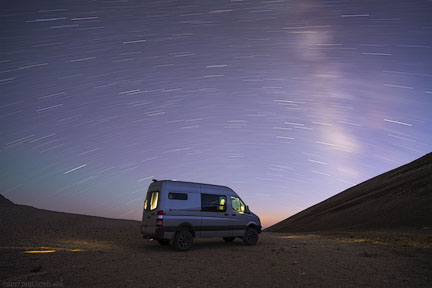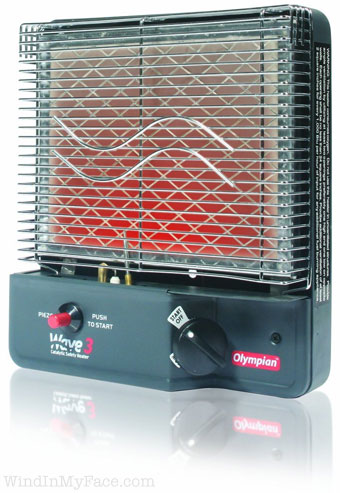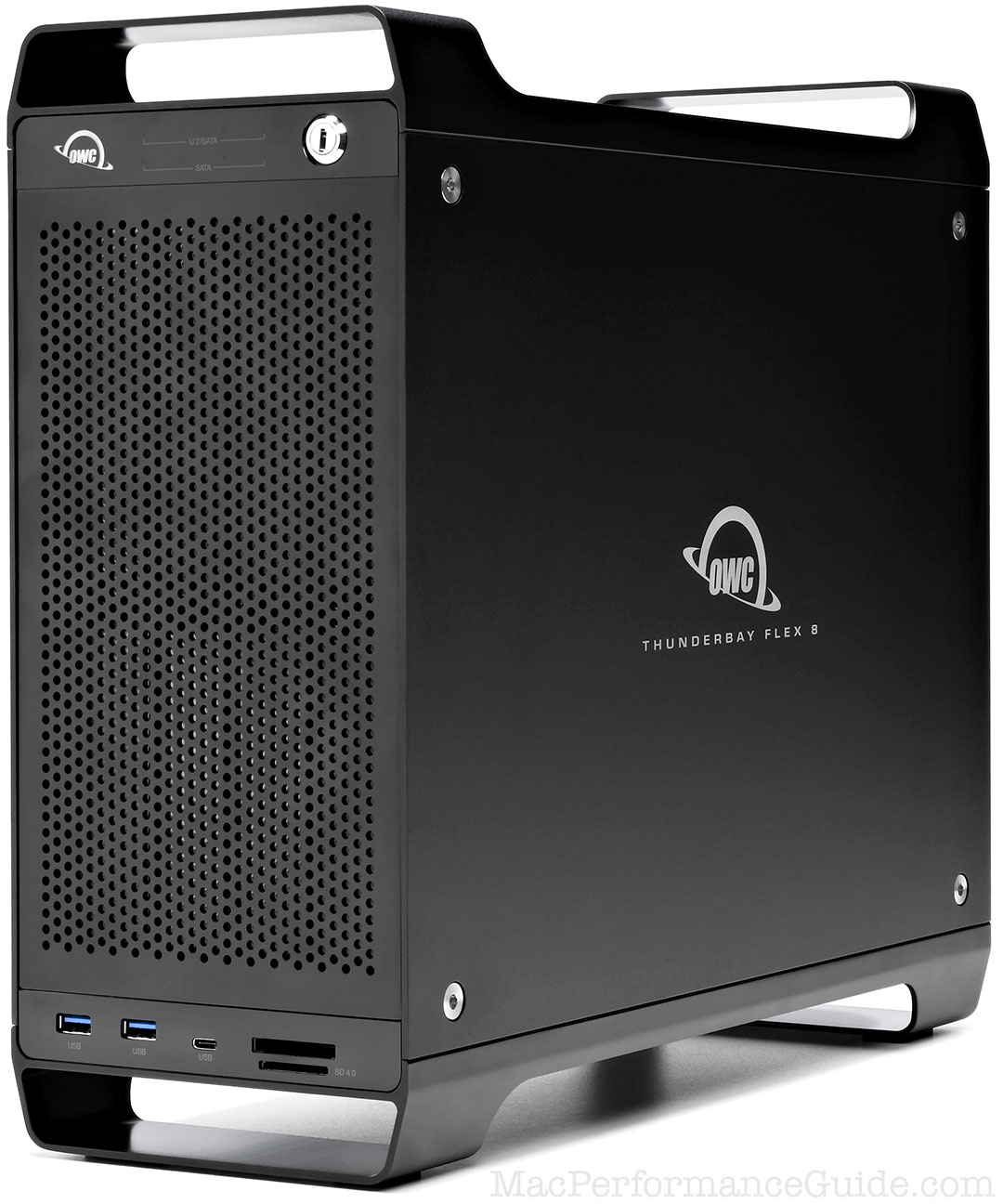
$220 SAVE $130 = 37.0% Western Digital 16.0TB Western Digital Ultrastar DC HC550 3.5-in… in Storage: Hard Drives
|

$500 SAVE $75 = 13.0% OWC 1.0TB OWC Atlas Pro SDXC V60 UHS-II Memory Card (2-Pack) in All Other Categories
|

|

|

|

|
Mercedes Sprinter: Heating the Cabin in Sub-Freezing Weather (Propane and Diesel Heaters)
Photographer and cyclist and Mac expert and software engineer Lloyd Chambers is available for consulting on general Sprinter considerations at his usual consulting rates via phone, or in person in the Palo Alto, CA area. Save yourself hours and mistakes by discussing issues up-front. More about Lloyd....

Heating a large volume vehicle like the Sprinter HighRoof van can take a lot of energy that the built-in front-seat heater cannot handle.
Carbon monoxide from a cabin heater or water heater or grill or stove or similar can kill you—see what my tests say about CO in Beware all Heaters and Engine Idling: Carbon Monoxide Detectors.
When installing a heater, be sure to add a carbon monoxide detector @AMAZON (get an industrial grade unit like the CO Inspector Industrial by Sensorcon @AMAZON, cheap ones are slow to respond).
Factory options
While the Mercedes Sprinter offers the "HZ5 Heavy Duty Fuel-fired pre-heater / booster (34,000 BTU)", that option is about wireless remote and engine pre-heating and is tied to the engine running—not very useful for me or anyone who wants heat while parked.
The dual-function hot-water auxiliary heater operates both as a heater booster and as an auxiliary (stationary) heater. The booster (10 KW [34,000 BTU]) mode is activated automatically as a function of coolant temperature, whenever the engine is switched on. An indicator light comes on whenever the booster function is active. When the engine has been switched OFF, the heater booster continues to run for approx. 2 minutes.
The auxiliary heater (5 KW [17,000 BTU]) can be switched on with a switch with indicator light. The indicator light comes on whenever this function is active. The maximum heating time is 60 minutes. Heating operation is also dependent on the coolant temperature. After the engine is switched off the auxiliary heater will continue to run for 15 minutes. If both the auxiliary heater and heater booster functions are activated, the auxiliary heater has priority. After the auxiliary heater function has been switched off, either manually or automatically, the heater booster is activated automatically.
My goals for heating
My use case and preferences are as follows:
- Heating the cabin with the engine off in temperatures as low as 0°F though typically not below 18°F. The large amount of glass (windshield and cabin windows, side windows) will let a lot of heat escape. Window shades can reduce heat loss, but only so much.
- Low power and fuel consumption.
- Ideally, no overhead/maintainance especially in summer months and when not using van.
- Keeping the lithium battery for computers above freezing, not to mention my hands and feet.
- Must operate safely (carbon monoxide) at altitudes up to 11,600' / 3535 meters.
Field use proves that electric power is a viable approach for my use because the Mercedes Sprinter alternator can output about 115 amps at 800 rpm idle with an appropriate load.
My power requirements when computing in sub-freezing temperatures are are as shown below. There is no realistic way to sustain this load except by idling the Sprinter engine. It can supply 80% of the required load at idle, but idling for hours chews up fuel. On one cold night I was down to 66% State of Charge (SoC), and that had dropped to 49% by morning due to leaving a compute not fully sleeping. I had hours of computing ahead, so I was forced to idle the engine for a time (which is not all bad, as that can also heat the cabin substantially). The point here is that one 5 kW lithium battery is not really enough to compute and stay warm without idling the Sprinter engine continually. Insulation will help considerably, as will not having 40 mph winds in sub-freezing temperatures as one night at 11,600' elevation those winds buffetted the sprinter for some hours, before dropping off to 10-15 mph down to 25°F and getting to 17°F later with the wind subsiding.
I’ve settled on electric heating. It is certainly not for most users (10 kW or so needed), but neither propane nor diesel can perform at high altitude (9000' to 11,600'), and there are no health risks with interior electric heating.


Propane heaters
Propane heaters offer many advantages:
- Far lower cost compared to diesel heaters (1/20 to 1/15 of the cost of an installed diesel heater!).
- Camco catalytic heater @AMAZONrated safe to 12,000' / 3658 meters with models like the Camco Wave-3 @AMAZON and Camco Wave-6 @AMAZON outputting up to 3000 and 6000 BTU, respectively.
TESTING SHOWS THAT SAFETY CLAIMS ARE FALSE, USE EXTREME CARE AT HIGH ALTITUDE. - Propane heaters can be permanently installed, but can also be set up and removed when not needed—perfect for summer camping (leave behind).
- Low weight, compact form factor, no van modifications needed for portable/removable units.
- Propane readily available in many different tank sizes.
- Propane can be used for cooking and other purposes; it is a multi-purpose fuel.
For my needs at high altitude, a Camco catalytic heater @AMAZON seemed safer, far cheaper, and far more flexible (can take or leave behind). But testing proved otherwise.
8-bay Thunderbolt 3
2.5 or 3.5 inch hard drives, NVMe SSD, USB-C, USB-A, DisplayPort 1.4, SD slot, PCIe slot, 500W power supply.
Non-RAID or RAID-0/1/4/5/10.
Capacities up to 128 Terabytes!
Tested at altitude: Camco Olympian Wave-3 and Wave-6 heaters = danger
DANGER: the discussion on the carbon monoxide detector page.
I cannot recommend the Camco heaters, at least not when run on high and/or at altitude—they are clearly unsafe in spite of marketing claims as “safe to 12000' elevation”.
Diesel heaters
Diesel heaters sound ideal, since one can be installed under the van chassis without reducing clearance for offroad use. They are a terrific choice for most users.
For my needs however, the Webasto folks have no confidence in their product at the altitudes I frequent (generally 8000' elevation minimum up to 11,600'). They suggested I spend my own money to see if it would work well or not (about $4500 installed with high altitude kit which is only to 7000' or so). They did not want to play ball on using me as a tester to see how their product works; this level of ignorance and unwillingness to support and understand their product was a big turn-off. So I have rejected diesel heating as an option both for cost and operational issues.
The Webasto Air Top 2000 STC looks promising (see the video on that page); see also the general FAQ which among other things states that it can be adjusted to operate at higher altitudes than 2200m / 7200 ft elevation. There may be some noise issues, see this post discussing simple and cheap solutions.
- Fuel autonomy: Diesel fuel is uniform worldwide and available 24/7, all year long. A very precise monitoring of fuel supplies is possible via the fuel-gauge.
- Heating autonomy: Heating while driving is allowed worldwide. By supplying the heater with diesel out of the vehicle fuel tank, there is no need to search for fitting bottle connectors or hassle of exchanging gas bottles in foreign countries.
- More space: Gas bottles in motorhome can be reduced as they do last longer anyway and all Webasto heaters can be mounted outside the vehicle. This leads to significantly more space inside the motorhome.
- Less weight: In winter, more than 80% of LPG gas is needed only for interior heating. By using diesel operated heaters, the LPG gas bottles can be downsized to one single 5 kg bottle and up to 35 kg of additional load can be gained.
- Webasto heaters are designed and validated to be mounted outside the vehicle, for more valuable space inside. Air Top & Dual Top heaters can be mounted underfloor, into the doublefloor of the motorhome or inside the cabin. The Air Tops can even be tilted up to 90° if necessary. Thermo Top C heaters are usually mounted into the engine compartment or under the motorhome.
- The technology of diesel heaters made big steps forward since the first heaters were introduced. Together with specially configured motorhome heaters, Webasto provides silent application kits whose various accessories eliminate all possible disturbances (i.e. exhaust silencer, ultra-silent pump, etc…), for your comfort and the comfort of your campground neighbor.
- All Webasto heaters are tested and approved to work in a temperature range from -30° to +40°C or more. The fuel used in very cold regions where temperatures can fall considerably under 0°C (arctic diesel or winter diesel) is automatically mixed with additives to prevent freezing of the fuel. Besides using this fuel, no special preparation of the heater is needed. Basically, if your vehicle can drive, your heater will run as well.
- Each heater has an own fuel system with a dosing pump which takes the fuel directly and independently out of the vehicle fuel tank.
- The electrical consumption is depending on the heating power needed and the type of heater. For further details, please see the heater’s technical specifications. The Air Top 2000 ST, for example, needs only 14 to 29W. To maintain the temperature once set point is reached, the electrical consumption is at the lower level. With these low electrical consumptions, you can sleep quietly and do not have to worry about your heating autonomy. Webasto heaters are equipped with an under voltage protection and shut down before critical battery conditions, so that an engine start is still secured. Motorhome heaters are anyhow usually connected to a secondary battery and do not have any impact on the engine start.




